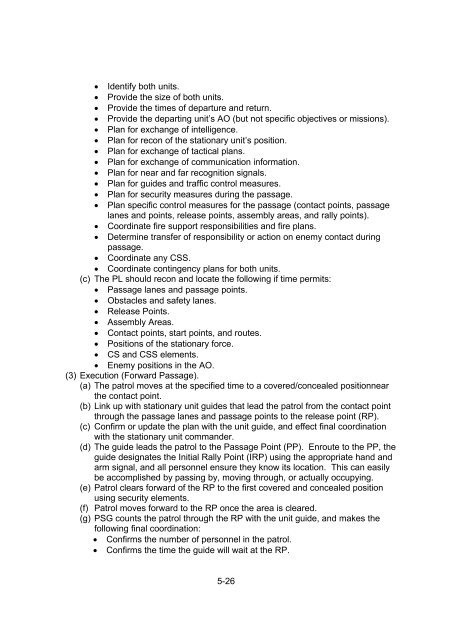Create successful ePaper yourself
Turn your PDF publications into a flip-book with our unique Google optimized e-Paper software.
• Identify both units.<br />
• Provide the size of both units.<br />
• Provide the times of departure and return.<br />
• Provide the departing unit’s AO (but not specific objectives or missions).<br />
• Plan for exchange of intelligence.<br />
• Plan for recon of the stationary unit’s position.<br />
• Plan for exchange of tactical plans.<br />
• Plan for exchange of communication information.<br />
• Plan for near and far recognition signals.<br />
• Plan for guides and traffic control measures.<br />
• Plan for security measures during the passage.<br />
• Plan specific control measures for the passage (contact points, passage<br />
lanes and points, release points, assembly areas, and rally points).<br />
• Coordinate fire support responsibilities and fire plans.<br />
• Determine transfer of responsibility or action on enemy contact during<br />
passage.<br />
• Coordinate any CSS.<br />
• Coordinate contingency plans for both units.<br />
(c) The PL should recon and locate the following if time permits:<br />
• Passage lanes and passage points.<br />
• Obstacles and safety lanes.<br />
• Release Points.<br />
• Assembly Areas.<br />
• Contact points, start points, and routes.<br />
• Positions of the stationary force.<br />
• CS and CSS elements.<br />
• Enemy positions in the AO.<br />
(3) Execution (Forward Passage).<br />
(a) The patrol moves at the specified time to a covered/concealed positionnear<br />
the contact point.<br />
(b) Link up with stationary unit guides that lead the patrol from the contact point<br />
through the passage lanes and passage points to the release point (RP).<br />
(c) Confirm or update the plan with the unit guide, and effect final coordination<br />
with the stationary unit commander.<br />
(d) The guide leads the patrol to the Passage Point (PP). Enroute to the PP, the<br />
guide designates the Initial Rally Point (IRP) using the appropriate hand and<br />
arm signal, and all personnel ensure they know its location. This can easily<br />
be accomplished by passing by, moving through, or actually occupying.<br />
(e) Patrol clears forward of the RP to the first covered and concealed position<br />
using security elements.<br />
(f) Patrol moves forward to the RP once the area is cleared.<br />
(g) PSG counts the patrol through the RP with the unit guide, and makes the<br />
following final coordination:<br />
• Confirms the number of personnel in the patrol.<br />
• Confirms the time the guide will wait at the RP.<br />
5-26


